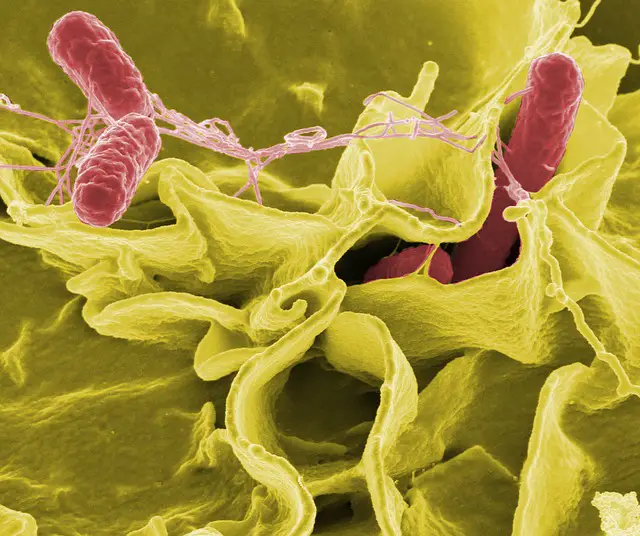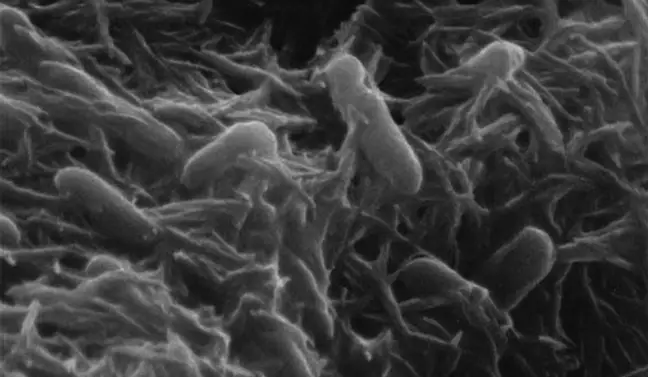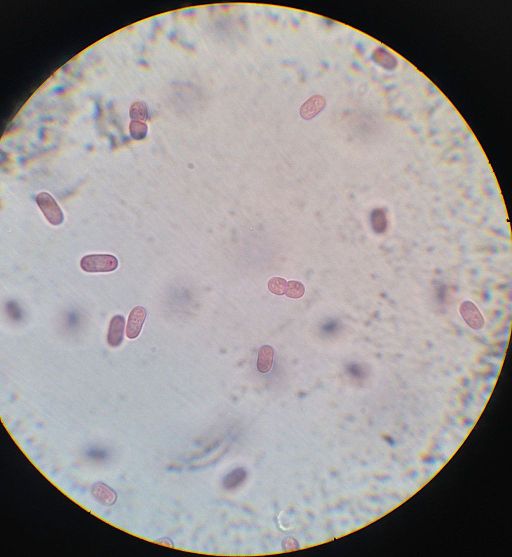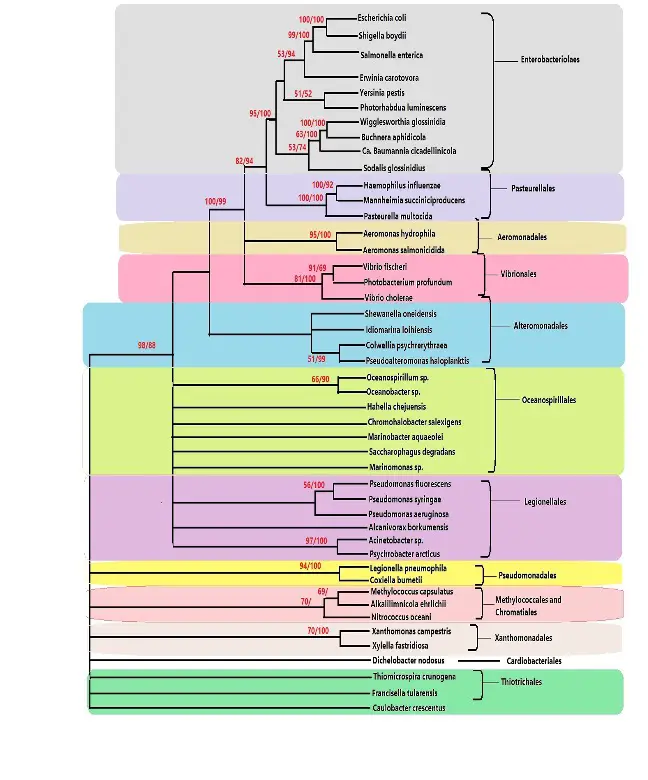Gammaproteobacteria
** Examples, Phylogeny, and Classification
Overview
Gammaproteobacteria is a large and diverse group with an estimated 250 genera. The majority of species in this class are unicellular organisms found in terrestrial and aquatic ecosystems.
While about 50 species in the group can cause diseases in human beings, many others exist as symbionts, commensals, and free-living species in various ecological niches. Moreover, they have several applications including the treatment of wastewater and serving as a source of energy.
Some examples of species within the class Gammaproteobacteria include:
- Legionella pneumophila
- Yersinia pestis
- Vibrio cholerae
- Pseudomonas aeruginosa
- Escherichia coli
- Thiomargarita namibiensis
Classification
Domain: Bacteria - They have a cell wall and lack membrane-bound organelles
Phylum: Proteobacteria - A large group of Gram-negative bacteria
Class: Gammaproteobacteria - Discussed below
Gammaproteobacteria Examples
The class Gammaproteobacteria is divided into 14 major Orders.
The following is a highlight of these Orders and examples of species in each group:
Enterobacteriales
Enterobacteriales are a large group of rod-shaped, Gram-negative bacteria in CLASS . Members of this order are facultative anaerobes and do not have spores. They are also diverse and can be found in different habitats as free-living, symbiotic, or parasitic organisms.
For instance, members of the genus Enterobacter can be found living freely in the soil or in association with plants. They can also be found on human skin (as commensals), in sewage, and intestinal tract of various animals.
Others like Yersinia pestis and Escherichia coli are parasitic and cause disease in human beings. Other species can be found in aquatic habitats or in association with various insects.
* Currently, the Order Enterobacteriales consists of over 250 species.
* The phylogeny of Enterobacteriales species is largely based on the 16S rRNA gene.
Some of the other characteristics of Enterobacteriales include:
- Rod-shaped with rounded ends
- Measure between 1 and 5 um in length and 0.3 to 0.6 um in diameter
- Many species move by means of flagella
Examples of species within this group include:
- Salmonella bongori
- Salmonella enterica
- Citrobacter farmeri
- Dickeya dadantii
- Pectobacterium carotovorum
- Brenneria salicis
Pseudomonadales
Pseudomonadales is a fairly large group of Gram-negative bacteria IN CLaa Gammaproteobacteria. Pseudomonadales species are also diverse with different morphologies. For instance, whereas some of the species are spherical (e.g. Rugamonas ruba, Azomonas, and some Rhizobacteria), others may be straight rods, slightly curved rods (e.g. Pseudomonas), or spiral in shape.
Some of the species are parasitic and cause diseases in human beings and animals (e.g. Pseudomonas syringae and some Acinetobacter species) while others like Azotobacter can be found in soil or in association with plants.
Some like Azotobacter move by means of flagella (peritrichous flagella) and form cysts in the event of unfavorable conditions. However, others like Azomonas do not form cysts and lack flagella for movement.
* Some species have been shown to contain photosynthetic pigments while others like Pseudomonas fluorescens promote the process in some plants.
Some of the other characteristics associated with pseudomonadales include:
- They have a G+C content of between 43.1 and 68.6 percent
- Range from 0.5 to over 10 um in length
Example of Pseudomonadales species include:
- Moraxella catarrhalis
- Acinetobacter baumannii
- Pseudomonas aeruginosa
- Pseudomonas chloroaphis
- Azomonas agilis
- Rugamonas rubra
Alteromonadales
Alteromonadales is a large group with over 400 species. Like many other Gammaproteobacteria, Alteromonadales are rod-shaped (straight or slightly curved), Gram-negative species many of which move by means of a single flagellum.
A great majority of species are marine organisms and can be found in various marine and coastal niches. However, others can be found in freshwater, sandy sediments, and various terrestrial habitats.
With regard to nutrition, many of the species have been shown to be chemoheterotrophs. As such, they obtain energy from a variety of organic materials in their surrounding (anaerobically or aerobically).
Whereas some of the members are facultative anaerobes (can survive in the presence or absence of oxygen, E.g. Shewanella), others are strict aerobes and need oxygen for growth.
Here, however, it's worth noting that growth by fermentation is not common even in anaerobic conditions. While the majority of species are aquatic organisms, some of the species can be found in extreme habitats.
For instance, Colwellia and Shewanella species (normal flora of fish) can be found in niches with very low temperatures (Psychrophile) and high pressure (piezophilic).
Some of the other characteristics of Alteromonadales include:
- Many species are Alteromonadales and grow well under moderate temperatures
- The majority are catalase and oxidase positive
- Need sodium ions for growth
- Some of the species (e.g.) are pigmented
Some example of Alteromonadales species in class Gammaproteobacteria include:
- Colwellia psychrerythraea
- Shewanella putrefaciens
- Shewanella oneidensis
- Marinobacter aquaeolei
- Pseudoalteromonas tunicata
- Alteromonas stellipolaris
- Colwellia psychrerythraea
Vibrionales
Members of the Order Vibrionales in class Gammaproteobacteria are Gram-negative species characterized by a rod-shaped morphology. Here, most of the species are curved while a few are straight or slightly spiral. They move by means of a polar flagellum. However, a few species have been shown to produce lateral flagella under some conditions (in culture).
The majority of Vibrionales species are aquatic organisms where they exist as pathogens. In these environments, they have been shown to infect and cause diseases to many invertebrates. However, some of the species (E.g. bioluminescent species) form a mutually beneficial relationship with various sea animals. On land, some (e.g. some Vibrio and Proteus species) are pathogens of human beings and animals.
Some of the other characteristics associated with Vibrionales include:
- Are facultative anaerobes
- The majority of species do not form spores
- Are oxidase-positive
- Chemoorganotrophs
- Carry out fermentation under anaerobic conditions
- While many are marine organisms, they can also be found in fresh and brackish water
Example of Vibrionales species include:
- Vibrio vulnificus
- Vibrio alginolyticus
- Listonella anguillarum
- Enterovibrio norvegicus
- Salinivibrio costicola
Pasteurellales
The Order Pasteurellales in class Gammaproteobacteria is made up of a single family (Pasteurellaceae). Members of this group are Gram-negative and exist as commensals or potential parasites of many birds and animals (vertebrates). Depending on the species, they vary from rod-shaped (e.g. Actinobacillus) to ovoid and coccibacilli (e.g. Haemophilus and Pasteurella species).
Many of the species are non-flagellated and thus immotile. They are also facultative anaerobes and therefore can survive in the presence or absence of oxygen. As mentioned, the majority of species in this group exist as pathogens, potential pathogens, or commensals. As such, they are commonly found living in their respective hosts.
For instance, some Pasteurella species, commonly associated with animals like cats and dogs, can cause skin disease (cellulitis) in human beings. The bacterium Pasteurella multocida is part of the normal flora in the digestive and respiratory tract of various animals.
Some of the other characteristics of Pasteurellales include:
- Have a small genome
- Are oxidase-positive
- Some species (e.g. Pasteurella species) may exhibit bipolar staining
- Occur singly or can form short chains
Examples of species in this group include:
- Aggregatibacter actinomycetemcomitans
- Mannheimia haemolytica
- Pasteurella multocida
- Actinobacillus pleuropneumoniae
- Avibacterium paragallinarum
Chromatiales
Members of the Order Chromatiales in class Gammaproteobacteria are Gram-negative bacteria that exhibit significant diversity in morphology and lifestyle. Whereas some are spherical, others are rod-shaped while some of the species appear vibroid. For instance, members of the genus Chromatium are generally rod-shaped (slightly curved or straight) while Ectothiorhodospira species are spiral-shaped.
With regard to motility, some of the species can move by means of polar flagella (E.g. Chromaium species) while others like Thiohalocapsa are non-motile. The majority of Chromatiales are Purple sulfur bacteria and are capable of photosynthesis.
They can be found in various anoxic , anaerobic and microaerobic conditions, including hot springs, intermedial zones, and microbial mats where they use sulfide for photosynthesis (sulfide acts as the electron donor).
Other characteristics of Chromatiales include:
- Some of the species have gas vesicles. Among members of the family Chromatiaceae, the cells are characterized by sulfur globules
- Photosynthetic pigments include bacteriochlorophyll a or b and carotenoids
- Some of the species grow photoheterotrophically and thus use some organic material in their surrounding
- Because water is not used during photosynthesis, they do not produce oxygen
Some species of the Order Chromatiales include:
- Chromatium okapi
- Allochromatium vinosum
- Ectothiorhodospira vacuolata
- Halochromatium roseum
- Thiohalocapsa halophila
- Thiocapsa roseopersicina
Xanthomonadales
The order Xanthomonadales in class Gammaproteobacteria is a relatively large group that consists of Gram-negative rods. Many of the species grow in areas with moderate temperatures and can be found in both terrestrial and aquatic environments.
Here, however, some of the species (especially members of the genera Xylella and Xanthomonas) are phytopathogens and infect a variety of crops including banana, rice, almond, maple, tomatoes, and mulberry, etc.
In human beings, members of the genus Stenotrophomonas are opportunistic pathogens and can cause cystic fibrosis, especially among immunocompromised patients.
* Many of the species form colonies that are yellowish in color.
Other characteristics of Xanthomonadales species include:
- Some species in the genus Nevskia produce hyaline stalks
- Do not produce endospores/spores
- Some species can move by flexing (e.g. some Lysobacter species)
- Catalase-positive
- Obligate aerobes and thus need oxygen for growth
Examples of species in the Order Xanthomonadales include:
- Xylella fastidious
- Stenotrophomonas maltophila
- Lysobacter enzymogenes
- Arenimonas donghaensis
- Luteimonas lumbrici
- Xanthomonas oryzae
Thiotrichales
* The bacterium Thiomargarita namibiensis belongs to the Thiotrichales. It's one of the largest bacteria on earth that can grow to over 0.3 mm in diameter.
The Order Thiotrichales in class Gammaproteobacteria consists of a number of species distributed within the families Francisellaceae, Thiotrichaceae, and Piscirickettsiaceae. They are Gram-negative bacteria with variations in size and shape between different species.
Whereas Francisella species range from small rods to coccibacilli, many Piscirickettsiaceae (e.g. members of the genus Cycloclasticus) are rod-shaped. However, some of the species may appear ovoid under the microscope.
Some of the species in the Order can move by gliding or by means of flagella (E.g. Thiospira species) while others are non-motile (E.g. Francisella species).
Many Thiotrichales are aerobic and therefore need oxygen for growth. They can be found in land and aquatic environments where they exist as free-living, symbionts, or parasites of various animals.
Various Piscirickettsiaceae species are parasites of fish and cause disease in Salmon while Francisellaceae species like F. tularensis cause disease in mammals.
As well, Thiothrix, in the family Thiotrichaceae can be found living freely in wastewater and water containing sulfur while some of the species live harmoniously with different organisms in their surroundings.
Examples of Thiotrichales species include:
- Thiothrix fructosivorans
- Francisella halioticida
- Francisella noatunensis
- Francisella tularensis
- Thiothrix lacustris
- Piscirickettsia salmonis
Legionellales
Legionellales are rod-shaped Gram-negative bacteria many of which are facultative intracellular parasites. In the environment, some of the species can be found living freely in soil and sediments and some water systems. Here, however, they can be found in association with amoeba.
In some organisms (e.g. ticks), species like Coxiella burnetii have been shown to live as endosymbionts. However, they cause disease in human beings (Q fever) when they are transmitted from insects. Others, in the genus Legionella are responsible for pneumonia and have been shown to cause large outbreaks.
Some of the other characteristics associated with Legionellales include:
- Do not form spores
- Aerobic
Examples of Legionellales species in class Gammaproteobacteria:
- L. pneumophila
- Coxiella burnetii
- L. longbeachae
- L. polyplacis
Methylococcales
As the name suggests, members of the Order Methylococcales (methanotrophs) are methanotrophs. As such, they metabolize methane and play an important role in the global carbon cycle. They vary from cocci to rod-shaped and exist singly or in pairs. In rare cases, however, some species form short chains or exist in groups of four (tetrads).
Like many other Gammaproteobacteria, methanotrophs are Gram-negative bacteria. However, unlike many, they have a cyst-like stage which allows them to survive harsh environmental conditions.
Methylococcales can be found in a number of habitats in terrestrial and aquatic environments. These include the soil, marine sediments, groundwater, and natural gas sewage sludge, etc. They are also catalase and oxidase-positive and strictly aerobic.
Example of species in this group include:
- Methylomicrobium agile
- Methylobacter whittenburyi
- Methylomicrobium album
- Methylosoma difficile
- Methyloparacoccus murrellii
Oceanospirillales
The order Oceanospirillales in class Gammaproteobacteria consists of several families including Oleiphilaceae, Hahellaceae, Oceanospirillaceae and Halomonadaceae among a few others. They are all Gram-negative bacteria with variations in shape from rod-shaped to ovoid.
Many species move by means of polar flagella and live in aerobic environments (some are facultatively anaerobic). As heterotrophs, they survive on organic material obtained from their surroundings.
Some species in the Order Oceanospirillales include:
- Profundimonas piezophila
- Halomonas elongata
- Chromohalobacter salexigens
- Alteromonas communis
Acidithiobacillales
Acidithiobacillales are Gram-negative rods found in acidic and moderately thermophilic niches. In nature, they can be found in a number of habitats including acid mine drainage, coal waste, and thermal sulfidic spring water, etc.
In these habitats, they oxidize iron or sulfur and thus live a chemoautotrophic lifestyle.
Some examples of species in the Order Acidithiobacillales in class Gammaproteobacteria include:
- Thermithiobacillus plumbiphilus
- Thiobacillus tepidarius
- Acidithiobacillus thiooxidans
- Acidithiobacillus ferrooxidans
- Acidithiobacillus caldus
Cardiobacteriales
Cardiobacteriales are Gram-negative rods that measure between 1 and 6 um in length. Some of the species are facultative anaerobes while others are strict anaerobes that only grow in the absence or presence of very little oxygen. They are also chemoorganotrophs and therefore need organic material to survive.
While some Cardiobacterium species are part of the normal microbiota in the mouth and throat, others like Dichelobacter species are pathogen and can be found in ovine.
Example of species in the Order Cardiobacteriales in class Gammaproteobacteria include:
- Cardiobacterium hominis
- Dichelobacter nodosus
- Suttonella indologenes
- Cardiobacterium valvarum
Aeromonadales
Aeromonadales species are Gram-negative rods some of which move by means of a polar flagellum. Others like Tolumonas species are nonmotile. They are commonly found in aquatic environments including freshwater and brackish water.
Some of the species (e.g. members of the genus Aeromonas) can be found in dairy products and meat while others exist as parasites of vertebrate and invertebrate animals (snails, human beings, amphibians, etc.).
Depending on the species, they may exist as strict aerobes or facultative anaerobes (capable of surviving in the presence or absence of oxygen).
Example of species in this group include:
- Tolumonas auensis
- Tolumonas lignilytica
- Oceanisphaera donghaensis
- Oceanisphaera psychrotolerans
- Zobellella denitrificans
Return to Proteobacteria main page
Return from Gammaproteobacteria to MicroscopeMaster home
References
Beile Gao, Ritu Mohan and Radhey S. Gupta. (2009). Phylogenomics and protein signatures elucidating the evolutionary relationships among the Gammaproteobacteria.
Geert Huys. (2014). The Prokaryotes: The Family Aeromonadaceae.
Hafiz Sohail Naushad and Radhey S. Gupta. (2013). Phylogenomics and Molecular Signatures for Species from the Plant Pathogen-Containing Order Xanthomonadales.
Mobolaji Adeolu, Seema Alnajar, Sohail Naushad, and Radhey S. Gupta. (2016). Genome-based phylogeny and taxonomy of the ‘Enterobacteriales’: proposal for Enterobacterales ord. nov. divided into the families Enterobacteriaceae, Erwiniaceae fam. nov., Pectobacteriaceae fam. nov., Yersiniaceae fam. nov., Hafniaceae fam. nov., Morganellaceae fam. nov., and Budviciaceae fam. nov. Free.
Links
https://www.biologyonline.com/dictionary/gammaproteobacteria
https://www.sciencedirect.com/topics/immunology-and-microbiology/vibrionales
Find out how to advertise on MicroscopeMaster!








